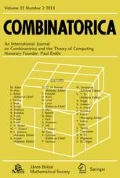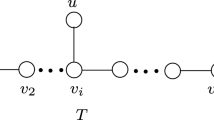Let be the Turán number which gives the maximum size of a graph of order containing no subgraph isomorphic to .
In 1973, Erdős, Simonovits and Sós [5] proved the existence of an integer such that for every integer , the minimum number of colours , such that every -colouring of the edges of which uses all the colours produces at least one all whose edges have different colours, is given by . However, no estimation of was given in [5]. In this paper we prove that for . This formula covers all the relevant values of n and p.
Similar content being viewed by others
Author information
Authors and Affiliations
Additional information
Received January 27, 1997/Revised March 14, 2000
Rights and permissions
About this article
Cite this article
Montellano-Ballesteros, J., Neumann-Lara, V. An Anti-Ramsey Theorem. Combinatorica 22, 445–449 (2002). https://doi.org/10.1007/s004930200023
Issue Date:
DOI: https://doi.org/10.1007/s004930200023




